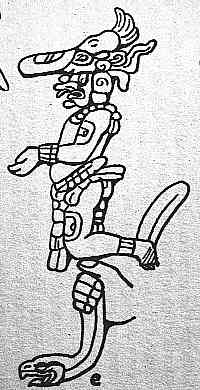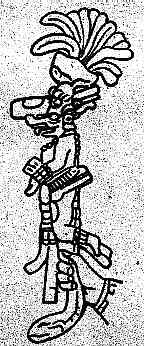



The Manikin Scepter appears in some Mayan carvings of chieftains in full regalia, and seems to have been a symbol of great power and authority. The manikin itself is a god-image, and the staff of the scepter is typically shown as a serpent, a powerful symbol itself, forming one of the god-image's legs. The above drawings of stelae (stone column) carvings illustrates these features (at least the left image is from the ancient Mayan site of Menche).
The Manikin Scepter may have evolved from the simpler ceremonial staff and ceremonial axe symbols, which in turn derived from, or were cognate with, the Ceremonial Bar symbol. In this way, the symbols of political status conjuring the power of serpents and god-images intertwined.
The symbol of the Manikin Scepter can be found in ancient Mayan stelae carvings, glyphs, and other places. For example, the following fresco from Temple of the Frescoes at Tulum shows a chieftain figure holding a Manikin Scepter in a pose of authority and power:
Another striking example of the Manikin Scepter appears in the following photo:
I took the above photo in 1980, after crawling through a dark underground chamber I discovered at the (at least then) still largely-unexcavated Mayan site of Dzibilchaltum on the Yucatan Peninsula in Mexico. This beautifully preserved carving clearly shows the chieftain's royal and elaborate headdress and the entirely sylized Manikin Scepter, here transformed from the simple Ceremonial Staff wholly into a god-image.
Back to the Ancient America Page
Back to The Knowledge Plexus